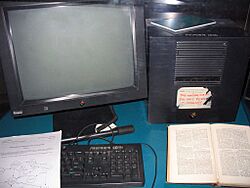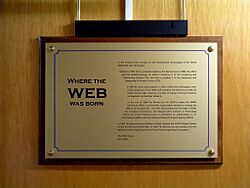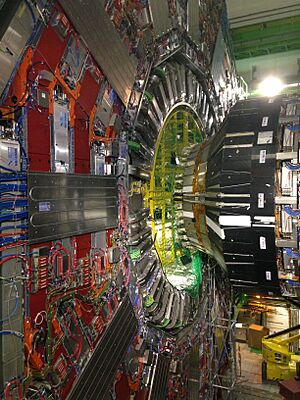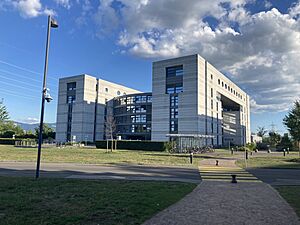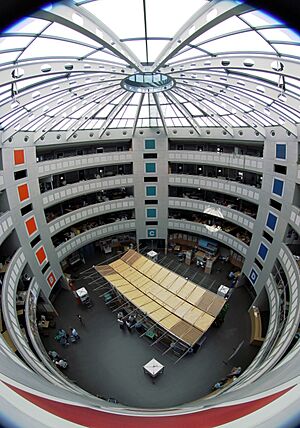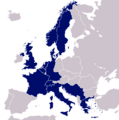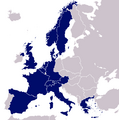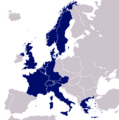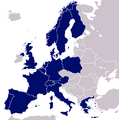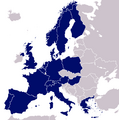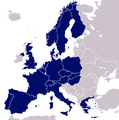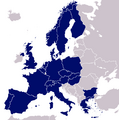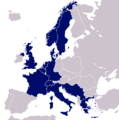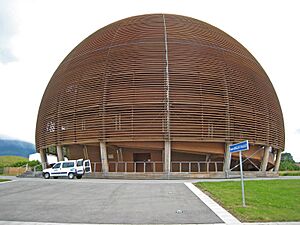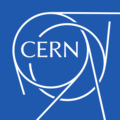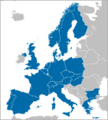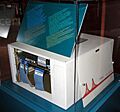CERN facts for kids
|
Organisation européenne pour la recherche nucléaire
|
|
 |
|
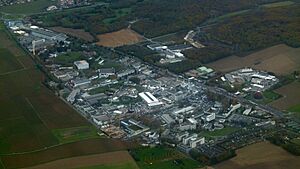
CERN's main site in Meyrin, Switzerland, looking towards the French border
|
|
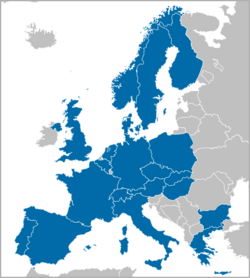
States with full CERN membership
|
|
| Formation | 29 September 1954 |
|---|---|
| Headquarters | Meyrin, Geneva, Switzerland 46°14′03″N 6°03′10″E / 46.23417°N 6.05278°E |
|
Membership
|
Full members (25):
|
|
Official languages
|
English and French |
|
Council President
|
Costas Fountas (German version) |
|
Director-General
|
Fabiola Gianotti |
|
Budget (2022)
|
1405m CHF |
CERN, which stands for the European Organization for Nuclear Research, is a special group that runs the world's biggest lab for particle physics. This means they study the tiniest parts of matter. CERN was started in 1954. It is located in Meyrin, a town near Geneva, right on the border between France and Switzerland.
CERN is like a huge science city. In 2023, it had over 2,600 staff members. It also hosted about 12,370 scientists from more than 80 countries. These scientists come to use CERN's amazing machines.
The main job of CERN is to provide powerful machines called particle accelerators. These machines help scientists explore the universe at its most basic level. CERN is home to the Large Hadron Collider (LHC). This is the world's largest and most powerful particle collider. CERN also has a huge computer center. It stores and analyzes all the data from experiments. It is also where the World Wide Web was invented!
Contents
How CERN Started
CERN was officially created on September 29, 1954. Twelve countries in Western Europe signed an agreement to start it. The name CERN first came from the French words for 'European Council for Nuclear Research'. This was a temporary group set up in 1952 to plan the lab.
Even after the temporary group was gone, the name CERN stuck. The full name changed to 'European Organization for Nuclear Research' in 1954. But everyone still called it CERN.
The first Director-General of CERN was Felix Bloch in 1954. The lab first focused on studying atomic nuclei. But soon, it moved to high-energy physics. This field studies how tiny subatomic particles interact. Because of this, CERN is often called the 'European laboratory for particle physics'. This name better describes the amazing research done there.
Countries That Started CERN
In 1953, 12 countries signed the agreement to create CERN. These countries were Belgium, Denmark, France, West Germany, Greece, Italy, the Netherlands, Norway, Sweden, Switzerland, the United Kingdom, and Yugoslavia. These countries gradually approved the agreement.
Amazing Discoveries at CERN
Scientists at CERN have made many important discoveries in particle physics. Here are some of them:
- 1973: They found neutral currents using the Gargamelle bubble chamber.
- 1983: They discovered the W and Z bosons in the UA1 and UA2 experiments.
- 1989: They figured out how many types of light neutrinos exist.
- 1995: They created the first antihydrogen atoms.
- 2000: The Heavy Ion Programme found a new state of matter called quark–gluon plasma.
- 2012: They discovered a new particle that matched the long-searched-for Higgs boson.
In 2011, there was a lot of talk about an experiment called OPERA. It seemed to show neutrinos traveling faster than light. But later, it was found that a cable was connected wrong. This showed how important it is to check everything carefully in science!
Many Nobel Prizes have been given for work done at CERN.
- In 1984, Carlo Rubbia and Simon van der Meer won for their work leading to the discovery of W and Z bosons.
- In 1992, Georges Charpak won for inventing particle detectors.
- In 2013, François Englert and Peter Higgs won for their ideas about the Higgs mechanism. This was after the Higgs boson was found at CERN.
How CERN Changed Computing
CERN was a pioneer in using TCP/IP for its computer network in 1984. This helped spread the use of the internet in Europe.
In 1989, the World Wide Web was invented at CERN by Tim Berners-Lee. He wanted to make it easier for scientists to share information. His idea was based on hypertext, which lets you link different pieces of information. His colleague, Robert Cailliau, joined him in 1990.
CERN announced on April 30, 1993, that the World Wide Web would be free for everyone to use. This decision helped the web become the main way people use the Internet today.
CERN also works on grid computing. This is a way to link many computers together to solve big problems. CERN also hosts the CERN Internet Exchange Point (CIXP). This is one of the main places where internet traffic is exchanged in Switzerland.
Particle Accelerators at CERN
Current Accelerators
CERN has a network of seven accelerators and two decelerators. These machines speed up or slow down tiny particles. Each machine in the chain boosts the particles' energy. This prepares them for experiments or for the next, more powerful accelerator.
Here are some of the active machines at CERN:
- The LINAC 3 and Linac4 are linear accelerators. They create low-energy particles. Linac4 is the source for all proton beams at CERN.
- The Low Energy Ion Ring (LEIR) speeds up ions from LINAC 3. It then sends them to the Proton Synchrotron.
- The Proton Synchrotron Booster increases the energy of particles. It sends them to other accelerators.
- The 28 GeV Proton Synchrotron (PS) was built in the 1950s. It still works today, feeding particles to other machines.
- The Super Proton Synchrotron (SPS) is a circular accelerator. It is 2 kilometers wide and started in 1976. It can speed up particles to 450 GeV. It also sends particles to the LHC.
- The On-Line Isotope Mass Separator (ISOLDE) studies unstable atomic nuclei.
- The Antiproton Decelerator (AD) slows down antiprotons. This helps scientists study antimatter.
- The Extra Low Energy Antiproton ring (ELENA) further slows down antiprotons. This makes them even easier to study.
The Large Hadron Collider (LHC)
A lot of CERN's work today involves the Large Hadron Collider (LHC). The LHC is a huge science project involving scientists from all over the world.
The LHC tunnel is 100 meters underground. It is located between the Geneva airport and the Jura mountains. Most of the 27-kilometer-long tunnel is in France. This tunnel used to house another accelerator called LEP. CERN's other accelerators prepare particles before they are sent into the LHC.
Eight main experiments are located along the LHC tunnel. These include CMS, ATLAS, and ALICE. Each experiment studies particle collisions in a different way. Building these experiments required amazing engineering. For example, a special crane was needed to lower parts of the CMS detector. Some pieces weighed almost 2,000 tons!
The LHC creates huge amounts of data. CERN sends this data to labs worldwide for processing. This uses a special grid system called the LHC Computing Grid.
The LHC started circulating its first particle beams on September 10, 2008. But it stopped 10 days later due to a faulty magnet. After repairs, it restarted on November 20, 2009. Engineers then had the challenge of making the beams collide. This was like "firing two needles across the Atlantic and getting them to hit each other."
On March 30, 2010, the LHC successfully collided two proton beams. This created a total collision energy of 7 TeV. This was enough to start the main research, including the search for the Higgs boson. In July 2012, CERN scientists announced they had found a new particle. It was later confirmed to be the Higgs boson.
In early 2013, the LHC was shut down for two years for maintenance. This allowed engineers to strengthen connections and make other upgrades. On April 5, 2015, the LHC restarted for its second run. It reached a record energy of 6.5 TeV per beam. In 2016, it even exceeded its planned collision rate. Another two-year shutdown for upgrades began at the end of 2018.
Future Accelerators
CERN is working on upgrading the LHC. This project is called the High Luminosity LHC (HL-LHC). It aims to make the LHC even more powerful by 2026.
CERN is also looking into building even bigger accelerators in the future. One idea is a linear electron-positron collider. Another is a much larger version of the LHC, called the Future Circular Collider.
Old Accelerators
CERN has also decommissioned several accelerators over the years. These include:
- The original linear accelerators, LINAC 1 and LINAC 2.
- The 600 MeV Synchro-Cyclotron (SC), which operated until 1991. It is now a public exhibition.
- The Intersecting Storage Rings (ISR), an early collider that ran until 1984.
- The Large Electron–Positron Collider (LEP), which operated from 1989 to 2000. Its tunnel is now used by the LHC.
- The Low Energy Antiproton Ring (LEAR), which created the first pieces of true antimatter in 1995. It closed in 1996.
CERN's Locations
CERN's smaller accelerators are on its main site in Meyrin. This site started in Switzerland but has grown to cross the French border. There's no clear border line within the site itself.
The tunnels for the SPS and LHC are mostly underground. They are buried under French farmland. There are surface sites above them for experiments or other facilities. These experiments are located deep underground, at the same level as the tunnels.
Many roads at CERN are named after famous physicists. These include Wolfgang Pauli, Richard Feynman, Albert Einstein, and Niels Bohr.
How CERN is Funded
Member Countries and Their Contributions
Since it started in 1954, CERN has welcomed new member countries. Currently, there are 25 full member states. Israel, which joined in 2014, is the only full member not in Europe.
Countries contribute to CERN's budget based on their economic size (GDP).
| Member state | Status since | Contribution (million CHF for 2019) |
Contribution (fraction of total for 2019) |
|---|---|---|---|
| Founding Members | |||
| 29 September 1954 | 30.7 | 2.68% | |
| 29 September 1954 | 20.5 | 1.79% | |
| 29 September 1954 | 160.3 | 14.0% | |
| 29 September 1954 | 236.0 | 20.6% | |
| 29 September 1954 | 12.5 | 1.09% | |
| 29 September 1954 | 118.4 | 10.4% | |
| 29 September 1954 | 51.8 | 4.53% | |
| 29 September 1954 | 28.3 | 2.48% | |
| 29 September 1954 | 30.5 | 2.66% | |
| 29 September 1954 | 47.1 | 4.12% | |
| 29 September 1954 | 184.0 | 16.1% | |
| 29 September 1954 | 0 | 0% | |
| Acceded Members | |||
| 1 June 1959 | 24.7 | 2.16% | |
| 1 January 1983 | 80.7 | 7.06% | |
| 1 January 1986 | 12.5 | 1.09% | |
| 1 January 1991 | 15.1 | 1.32% | |
| 1 July 1991 | 31.9 | 2.79% | |
| 1 July 1992 | 7.0 | 0.609% | |
| 1 July 1993 | 10.9 | 0.950% | |
| 1 July 1993 | 5.6 | 0.490% | |
| 11 June 1999 | 3.4 | 0.297% | |
| 6 January 2014 | 19.7 | 1.73% | |
| 17 July 2016 | 12.0 | 1.05% | |
| 24 March 2019 | 2.5 | 0.221% | |
| 30 August 2024 | 1.0 | N/A | |
| 21 June 2025 | 1.0 | N/A | |
| Associate Members in the pre-stage to membership | |||
| 1 April 2016 | 1.0 | N/A | |
| Associate Members | |||
| 6 May 2015 | 5.7 | N/A | |
| 31 July 2015 | 1.7 | N/A | |
| 5 October 2016 | 1.0 | N/A | |
| 16 January 2017 | 13.8 | N/A | |
| 8 January 2018 | 1.0 | N/A | |
| 10 October 2019 | 0.25 | N/A | |
| 2 August 2021 | N/A | ||
| 13 March 2024 | N/A | ||
| 8 May 2025 | N/A | ||
| Total Members, Candidates and Associates | 1,171.2 | 100.0% | |
| Maps of the history of CERN membership |
|---|
|
Growing Membership
CERN also has "Associate Members" and "Observer" countries. These countries work closely with CERN.
- Turkey became an associate member in 2015.
- Pakistan became an associate member in 2015.
- Cyprus became an associate member in 2016.
- Ukraine became an associate member in 2016.
- India became an associate member in 2017.
- Slovenia became an associate member in 2017.
- Lithuania became an associate member in 2018.
- Croatia became an associate member in 2019.
- Latvia became an associate member in 2021.
- Brazil became the first associate member from the Americas in 2024.
- Ireland was approved as a new Associate Member State in March 2025.
Observer Countries and Organizations
Some countries and international groups have "observer status" at CERN. This means they can attend meetings and stay informed.
- Japan – since 1995
- United States – since 1997
- UNESCO – since 1954
- European Commission – since 1985
Open Science at CERN
CERN strongly believes in Open Science. This means making scientific research available to everyone. It also means using open tools and processes to create knowledge.
CERN's founding agreement in 1953 said that all its results should be published. In 2014, CERN made a policy for open access. This means all papers by CERN authors are freely available. More recently, they added an open data policy. This means scientific data from LHC experiments is also made public after a certain time.
CERN also helps create tools and services for open science. For example, they started SCOAP3. This project helps make scientific articles in high-energy physics open access.
CERN also has online services like the CERN Open Data portal and Zenodo. These help researchers share their documents, data, and software.
Visiting CERN
The CERN Science Gateway opened in October 2023. It is a new place for science education. It has exhibits, workshops, and shows.
The Globe of Science and Innovation opened in 2005. It is open to the public and hosts special exhibits.
The Microcosm museum used to have an exhibition about particle physics. It closed in 2022 to make way for the Science Gateway.
CERN also offers daily tours. You can see facilities like the Synchro-cyclotron. This was CERN's first particle accelerator.
In 2004, a two-meter statue of Nataraja was put up at CERN. Nataraja is a dancing form of the Hindu god Shiva. The statue symbolizes Shiva's cosmic dance of creation and destruction. It was a gift from the Indian government. A plaque explains how this ancient idea connects with modern physics.
Art at CERN
CERN started its Arts at CERN program in 2011. This program helps connect art and physics.
Since 2012, Arts at CERN has brought artists to the lab. They come to see how science explores big questions about our universe. Artists from many different fields have visited CERN.
The Arts at CERN programs include:
- Collide: An international residency program with a partner city.
- Connect: A program to encourage art and science experiments at CERN and other science places.
- Guest Artists: Short stays for artists to learn about CERN's research.
More than 200 artists from 80 countries have taken part in these programs. They work with physicists and engineers at CERN.
Images for kids
-
This NeXT Computer used by British scientist Sir Tim Berners-Lee at CERN became the first Web server.
-
This Cisco Systems router at CERN was one of the first IP routers deployed in Europe.
-
A plaque at CERN commemorating the invention of the World Wide Web by Tim Berners-Lee and Robert Cailliau
-
A map of the Large Hadron Collider together with the Super Proton Synchrotron at CERN
-
ESO and CERN have a cooperation agreement.
See also
 In Spanish: Organización Europea para la Investigación Nuclear para niños
In Spanish: Organización Europea para la Investigación Nuclear para niños



